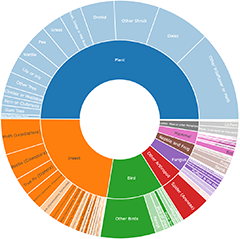Simple spore sac, with an apical hole [puffballs]
At maturity, a fruitbody of a fungus in this sub-group is essentially a spore sac, either roughly spherical or with an extended base (or pseudo-stem) and then somewhat pear-shaped. The spore sac holds the powdery spores within a bundle of entangled filaments (much like a wad of cotton-wool). The wall of the spore sac is thin and flexible with an apical hole through which the spores can puff out when the sac is compressed (e.g. by a raindrop, a falling twig, a finger) – hence the common name puffball. When the pressure eases, the compressed ‘cotton-wool’ expands, restoring the sac to its pre-puff shape and so allowing future puffs. Without the ‘cotton wool’, the spore sac would stay compressed and puff no more. When present, a pseudo-stem may be quite short or constitute more than half the height of the fruitbody. A pseudo-stem feels and (if cut open) looks much like foam plastic and is free of spores. It simply serves to raise the rounder, spore-filled upper part. In some species a membrane (or diaphragm) separates the spore-filled upper from the sterile base.
The outer surface of the immature fruitbody may be fairly smooth or with a rough coating (e.g. of granules or pyramidal warts). With age the rough coating erodes away, though often you will find remnants on the underside of a fruitbody since this is less exposed to erosion.
At maturity the fruitbody may be loose or remain attached to the substrate by a root-like bundle of fungal filaments.
In the following hints you see examples of useful identification features and a few of the more commonly seen genera in which at least some species (not necessarily all) show those features.
Hints
A pear-shaped fruitbody: Lycoperdon.
Lower half with a collar (or casing) that consists of soil grains glued together: Disciseda.
Warning
If the spore sac sits atop a stem check the fungi in Other puffballs & the like. In one genus the stem may be buried.
Announcements
There are currently no announcements.
Discussion
Lycoperdon sp.
Top contributors
- Csteele4 8
- Teresa 7
- Heino1 6
- JackyF 4
- Caric 4
- trevorpreston 4
- AlisonMilton 4
- CanberraFungiGroup 3
- Aussiegall 3
- shube 2
Top moderators
- Heino1 35
- Csteele4 11
- Teresa 10
- MichaelMulvaney 7
- Heinol 4
- Heino 4
- CanberraFungiGroup 4
- Pam 2
- Marthijn 0
- Eirheart 0


